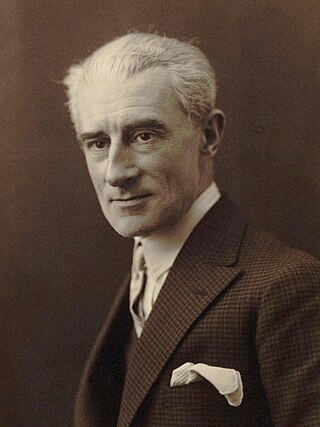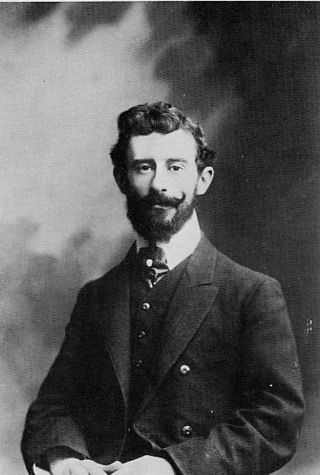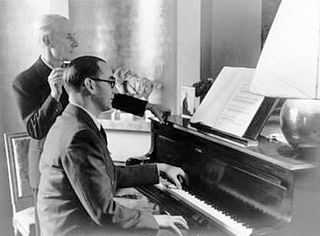Notes
- 1 2 3 4 "Arbie Orenstein", New York Philharmonic Orchestra, retrieved 2 April 2015
- ↑ " A Ravel centenary recital : six world premieres of works by Maurice Ravel", WorldCat, retrieved 2 April 2015
Arbie Orenstein (born 1937) is an American musicologist, author, academic and pianist, known as a scholar of the life and works of the composer Maurice Ravel and, more generally, as an expert on Jewish music.
Orenstein was born in New York and was educated at the High School of Music and Art, Queens College, and Columbia University, receiving a doctorate in musicology. [1] He is known as a Ravel scholar, and his books include The Vocal Works of Maurice Ravel (1968), Ravel: Man and Musician (Columbia Univ. Press, 1975) and Ravel: Lettres, Ecrits, Entretiens (Flammarion, 1989), translated into English as A Ravel Reader (Columbia Univ. Press, 1990). [1]
As a pianist, Orenstein has recorded the world premieres of works by Ravel. [2] He has also accompanied concert artists. In 1998 the French government awarded him the medal of Chevalier of the Ordre des Arts et des Lettres. [1]
Orenstein is a professor of music at the Aaron Copland School of Music at Queens College, where he has taught for 45 years, focusing on European music history and Jewish music. He is the editor of the Jewish music journal Musica Judaica and regularly contributes to the French journal Cahiers Maurice Ravel. [1]
Impressionism in music was a movement among various composers in Western classical music whose music focuses on mood and atmosphere, "conveying the moods and emotions aroused by the subject rather than a detailed tone‐picture". "Impressionism" is a philosophical and aesthetic term borrowed from late 19th-century French painting after Monet's Impression, Sunrise. Composers were labeled Impressionists by analogy to the Impressionist painters who use starkly contrasting colors, effect of light on an object, blurry foreground and background, flattening perspective, etc. to make the observer focus their attention on the overall impression.

Joseph Maurice Ravel was a French composer, pianist and conductor. He is often associated with Impressionism along with his elder contemporary Claude Debussy, although both composers rejected the term. In the 1920s and 1930s Ravel was internationally regarded as France's greatest living composer.

Boléro is a 1928 work for large orchestra by French composer Maurice Ravel. At least one observer has called it Ravel's most famous composition. It was also one of his last completed works before illness forced him into retirement.

Le Tombeau de Couperin is a suite for solo piano by Maurice Ravel, composed between 1914 and 1917. The piece is in six movements, based on those of a traditional Baroque suite. Each movement is dedicated to the memory of a friend of the composer who had died fighting in World War I. Ravel also produced an orchestral version of the work in 1919, although this omitted two of the original movements.

Jeux d'eau is a piece for solo piano by Maurice Ravel, composed in 1901 and given its first public performance the following year. The title is variously translated as "Fountains", "Playing Water" or literally "Water Games". At the time of writing Jeux d'eau, Ravel was a student of Gabriel Fauré, to whom the piece is dedicated. The work is in a single movement, typically lasting between four and half and six minutes in performance.
Les Apaches was a group of musicians, writers and artists which formed in Paris, France in 1903. The core was formed by the French composer Maurice Ravel, the Spanish pianist Ricardo Viñes and the writer and critic Michel-Dimitri Calvocoressi. The group was private but never formal, and the wider membership was fluid; over 20 unofficial members would attend meetings of Les Apaches until it came to an end during World War I. During their active years, Les Apaches met weekly. The meetings were a chance for the members to perform and show new works or ideas to a small group, discuss contemporary artistic interests and collaborate.

Maurice Ravel's Piano Concerto in G major, was composed between 1929 and 1931. The concerto is in three movements, with a total playing time of a little over 20 minutes. Ravel said that in this piece he was not aiming to be profound but to entertain, in the manner of Mozart and Saint-Saëns. Among its other influences are jazz and Basque folk music.

The Piano Concerto for the Left Hand in D major was composed by Maurice Ravel between 1929 and 1930, concurrently with his Piano Concerto in G major. It was commissioned by the Austrian pianist Paul Wittgenstein, who lost his right arm during World War I. The Concerto had its premiere on 5 January 1932, with Wittgenstein as soloist performing with the Vienna Symphony Orchestra.

Pavane pour une infante défunte is a work for solo piano by Maurice Ravel, written in 1899 while the French composer was studying at the Conservatoire de Paris under Gabriel Fauré. Ravel published an orchestral version in 1910 using two flutes, an oboe, two clarinets, two bassoons, two horns, harp, and strings.

Rapsodie espagnole is an orchestral rhapsody written by Maurice Ravel. Composed between 1907 and 1908, the Rapsodie is one of Ravel's first major works for orchestra. It was first performed in Paris in 1908 and quickly entered the international repertoire. The piece draws on the composer's Spanish heritage and is one of several of his works set in or reflecting Spain.

La valse, poème chorégraphique pour orchestre, is a work written by Maurice Ravel between February 1919 and 1920; it was first performed on 12 December 1920 in Paris. It was conceived as a ballet but is now more often heard as a concert work.
Maurice Ravel completed his String Quartet in F major in early April 1903 at the age of 28. It was premiered in Paris in March the following year. The work follows a four-movement classical structure: the opening movement, in sonata form, presents two themes that occur again later in the work; a playful scherzo second movement is followed by a lyrical slow movement. The finale reintroduces themes from the earlier movements and ends the work vigorously.
Shéhérazade is the title of two works by the French composer Maurice Ravel. Both have their origins in the composer's fascination with Scheherazade, the heroine and narrator of The Arabian Nights. The first work, an overture (1898), Ravel's earliest surviving orchestral piece, was not well received at its premiere and has not subsequently been among his most popular works. Four years later he had a much greater success with a song cycle with the same title, which has remained a standard repertoire piece and has been recorded many times.
Introduction and Allegro for Harp, Flute, Clarinet and String Quartet is a chamber work by Maurice Ravel. It is a short piece, typically lasting between ten and eleven minutes in performance. It was commissioned in 1905 by the Érard harp manufacturers to showcase their instruments, and has been described as a miniature harp concerto. The premiere was in Paris on 22 February 1907.

Chansons madécasses is a set of three exotic art songs by Maurice Ravel written in 1925 and 1926 to words from the poetry collection of the same name by Évariste de Parny.
Histoires naturelles is a song cycle by Maurice Ravel, composed in 1906. It sets five poems by Jules Renard to music for voice and piano. Ravel's pupil Manuel Rosenthal created a version for voice and orchestra. The cycle is dedicated to the mezzo-soprano Jane Bathori, who gave the first performance, accompanied by the composer, on 12 January 1907.

Pierre-Joseph Ravel (1832–1908) was a Swiss civil engineer and inventor, father of the composer Maurice Ravel. He was a pioneer of the automobile industry. He invented and drove the steam-powered automobile in the late 1860s, developed an acetylene-powered two-stroke engine, built the racing car that could achieve speeds of up to 6 kilometres per hour (3.7 mph) and built a vehicle that could perform a somersault.
Lucien Garban (1877–1959) was a French composer, music arranger and editor who wrote transcriptions still performed in the modern repertoire. The Bibliothèque nationale de France lists about twenty original works by Garban and a large number of transcriptions by other composers. Many of his works were published under the pen name Roger Branga. He was a member of Société des Apaches.
Pedro de Freitas Branco was a Portuguese conductor and composer.
Esprit Charles Henri Ghys was a French pianist, organist, composer and arranger of Belgian parentage, who is primarily known today as the first piano teacher of Maurice Ravel.